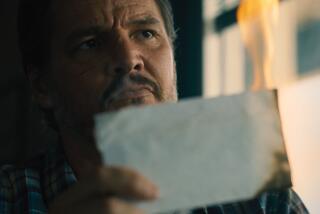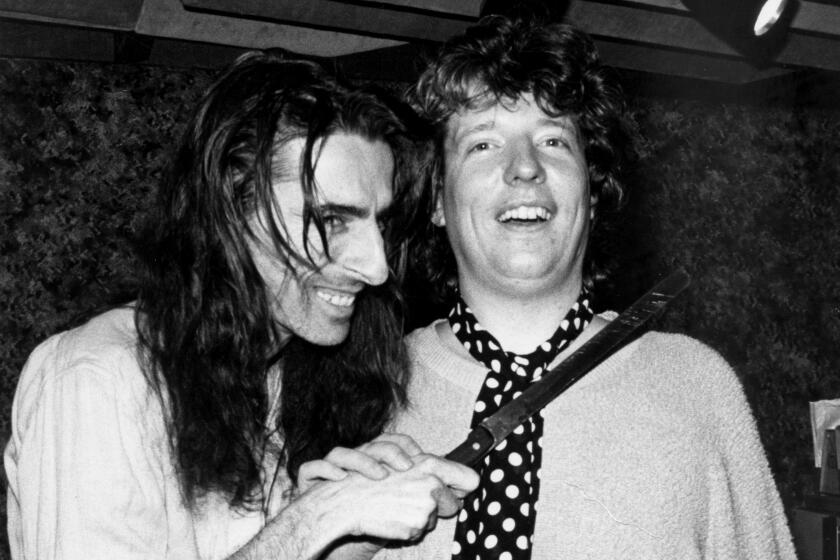O.C. punk exhibit showcases the sound and scene that ‘put punk rock on the map’

- Share via
In the early 1980s, at the peak of the punk rock scene in Fullerton, the interest and demand for punk in Orange County reached a boiling point during one particular TSOL show at Fullerton College.
The band was playing a room filled to capacity when an overzealous throng of people stormed the back door, causing chaos as a ceaseless current of punks flooded the building just to see the most feared and revered band in O.C. punk history. .
“You know when people are trying to get out of a building and they’re getting trampled? Well, these were people getting trampled on their way into a building,” the band’s vocalist, Jack Grisham, told The Times. “It was crazy, it was like people trying to get into Costco on a Thanksgiving morning, Black Friday, except they weren’t going for TVs and f—ing Xboxes, they were going for punk rock.”
Fullerton’s punk rock history is spotlighted as part of a larger celebration of Orange County punk at the Fullerton Museum Center, where a new exhibit called “Punk OC: From the Streets of Suburbia” is kicking off Saturday with an opening reception featuring live performances by D.I. and TSOL, Joe Escalante of the Vandals deejaying, and comedian Chris Estrada as the master of ceremonies. The exhibit runs through Aug. 10 and was put together by curators Georgette Collard and Jim Washburn.

“There was already a lot of punk enthusiasts here in Fullerton starting with our mayor at the time, and from there it was just kind of on the talks of ‘Hey, we should have a punk exhibit, all these great bands came from Fullerton’ … a lot of our board members were previously in the punk rock scene in their younger days, so everyone was just really excited to highlight and showcase that,” Collard said.
The exhibit chronicles O.C.’s punk history starting with the early Fullerton bands of the late 1970s like Eddie and the Subtitles, Social Distortion, Agent Orange, D.I. and Adolescents before moving through the decades and highlighting bands that rose from other cities in the county. Notable bands like TSOL, the Crowd, the Vandals and the Offspring will be among those featured, and an assortment of rare objects, artwork, flyers, photographs and personal mementos will be on display.
“I was impressed because one tends to think of punk as almost a disposable commodity, if people are living too fast you’d think they wouldn’t be preserving these things as they went along, and there’s a tremendous amount of stuff that people did save, it’s filling up the walls here,” Washburn said.

As a conservative region, O.C. may seem like an unlikely breeding ground for punk rock, especially compared with neighboring Los Angeles, but Grisham, who came up in the O.C. punk scene with his bandmates in TSOL, credits the area for innovating punk rock with a distinct sound that catapulted the music beyond local neighborhoods.
“L.A. had cool bands, but the Orange County sound — that surf skate sound that came out Orange County — that’s what blew punk rock up,” Grisham said. “Now, some people would like it that it never got blown up, that it just stayed in their own little basement, backyard, but that’s what really put punk rock on the map, the skaters, the surfers, the videos, the clothing, everything came out of that, it didn’t come out of these other areas.”
Even with the creation of this innovative sound, Orange County wasn’t easy to navigate for punk rockers in the late 1970s and early 1980s, according to Grisham, and its conservative grip on residents often made life difficult for outliers and creatives.
“You can go to downtown L.A. or whatever and you can dress crazy and no one’s even going to look at you, they don’t care, there’s so much craziness on the street, nobody gives a s—,” Grisham said. “You come down in a suburban neighborhood and go walking down somebody’s street with a leather jacket on and purple hair, there’s going to be a problem, you’re going to be stopped by the police, you’re going to be harassed, you’re going to be threatened, this is what we were going against down here.”
Grisham said that poverty and family dysfunction also marred the region, and it was no different there from anywhere else.
“Out of the four original TSOL guys, I was the only one that had like a together family unit, they were all broken families, divorced, torn up, all of them,” Grisham said.

According to the curators, the exhibit will help deconstruct preconceived notions about Orange County punk by exploring the diverse backgrounds and socioeconomic factors that prompted many bands to rebel and channel their creativity into the music.
“It was nice to learn a lot about it, I was, among other people, fairly dismissive of Orange County punk for a long time, you’d think, ‘You live in a bucolic paradise compared to where some of the punk music’s coming from, what are you upset about?’ Washburn said. “Then you talk to some of the people and realize how bullied they were in school, or what a horrible, broken family they came from and realize there was a lot of things driving them — just being outcasts in a society that looks perfect doesn’t make you feel any less outcast.”
Showcasing this juxtaposition and the community that grew out of it to create a vibrant music scene is one of the most impactful aspects of the “Punk OC” exhibit. At its core, it’s the resilience and community of the Orange County punk scene that is being illuminated and celebrated.
“One of my main goals for this exhibit is to educate the public, maybe people who don’t understand punk rock,” Collard said. “I want to educate people to show that this is an inclusive environment for punk rockers and that anyone is welcome to be in the punk scene — there’s a big sense of community in the punk rock scene and I think that will be evident in the exhibit.”
More to Read
The biggest entertainment stories
Get our big stories about Hollywood, film, television, music, arts, culture and more right in your inbox as soon as they publish.
You may occasionally receive promotional content from the Los Angeles Times.











